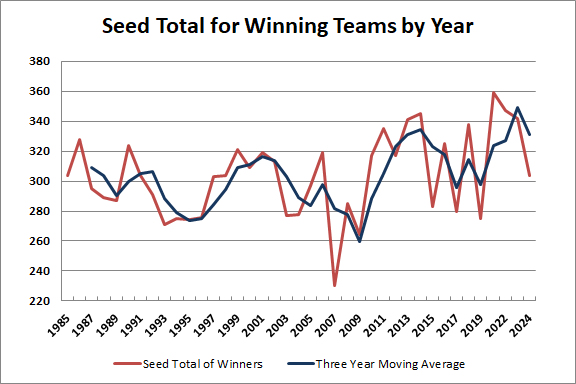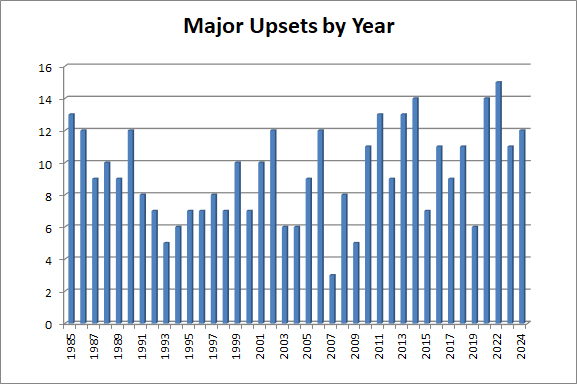 |
 |
 |
 |
Updated: March 17, 2025
In 2022, the #15 seeded St. Peter's Peacocks had probably the most improbable run in NCAA Tournament history. They defeated three top 20 teams to reach the Regional Final before losing to North Carolina. St. Peter's is the only #15 seed to win three NCAA Tournament games (out of 156). Only 11 of those 156 had even won their Round of 64 game. The year before had the highest Sum of Seeds (the combined total of the seed number of all winning teams from the Round of 64 to the Finals) of any tournament since the field expanded to 64 teams in 1985. Nine double-digit seeds won that year with four of those advancing to the Sweet Sixteen and two reaching the Regional Finals. #11 UCLA was in the Final Four. Since 1985, the average Sum of Seeds is 304. In four of the past six tournaments, that number has been 338 or higher so we are definitely seeing more upsets of late.
The following graph shows the aforementioned Sum of Seeds for all of the winning teams, starting with the round of 64 (the Tuesday/Wednesday games that have been added in recent years are not included). Though not perfect, I think that summing the winning seeds is a pretty good indicator of the performance of the underdogs from year to year. The blue line is the sum of all winning seeds. The red line is a three-year moving average of the sum of winning seeds.

Based on a Sum of Seeds total of 359, the 2021 tournament was the most upset-minded (upsetty? upsetacular?) in the 39 years of 64-team brackets. Coming in second and third are 2022 and 2023. The average Sum of Seeds total is 304 so clearly we've seen an uptick in upsets in the past few years. The big question is: will this trend continue? The moving average line suggests that upsets have been cyclical. From 1993-1996, the Sum of Seeds total was in the 270s, well below the average. From 1999-2002, we had above average upset activity (316/year) before a long period without a lot of big upsets (Sum of Seeds averaged 279 between 2003 and 2009 with only one year above 300). The period of 2010 to 2023 had mostly high upset years but with with three years where the Sum of Seeds dipped more than 20 below the average. Last year was exactly on the average of 394. Here are a few possible reasons for the increase in upsets:
First, the mid-major conferences (leagues not among the power conferences like the Big Ten, ACC or SEC, nor among the small conferences that rarely win an NCAA tournament game) seem to be catching up to the power conferences and playing tougher non-conference schedules than ever before. Playing teams from the power conferences in the regular season not only gives the mid-majors a taste for the type of tougher competition they will face in the NCAA Tournament but may also build confidence if they win or are highly-competitive in those games.
Second, star college basketball players continue to take the "one and done" approach before heading to the NBA so mini-dynasties are rare. When the tournament expanded to 64 teams in 1985, high school basketball standouts were not going directly to the NBA and college basketball stars often played through their senior seasons. This was good news for the top seeds who were loaded with talent and experience. The top programs still have little problem recruiting talent, but rarely can they mix that talent with experience (Think about how dominant Kevin Durant would have been had he played three or four years at Texas). High school to NBA and "one and done" has been increasing since the mid-1990s so it is hard to explain the relatively uspet-free period between 2003 and 2009 but generally speaking, the lure of the NBA should result in a higher number of upsets.
Another factor is the expansion to a 68 team tournament with four games feeding into the 64-team brackets. This improves the quality of the teams seeded 12 and higher. In the past, the four weakest automatic qualifiers would play the #1 seeds. Now, those four teams play each other, with two being knocked out before the Round of 64. This creates a domino effect in the 12 to 16 seeds. Two teams that would have been 15 seeds before are now 16 seeds, two teams that would have been 14 seeds are now 15 seeds, and so on. This means that the top four seeds are facing slightly tougher competition. Four at-large bid teams are also required to play a "First Round" game in order to advance to the Round of 64. The Tournament Selection Committee has some discretion when it comes to seeding these teams so it can create some pretty tough matchups for some top four seeds. Even this small expansion should make the early round games more competitive. In fact, I am a proponent of expanding to 70 or 72 teams. For nearly 30 years, the #1 seeds have essentially had a bye in the first round (154-2). Expansion to 70 or 72 teams would make things at least a little tougher for the top seeds.
Actual Number of Upsets by Year
The Sum of Winning Seeds Analysis described above gives us a good look at the overall performance of the weaker seeds on an annual basis but it doesn't really tell us how many uspets we've seen. For example, if the #12 and #13 seeds in the same region win in the Round of 64, they play each other in the Round of 32. If the #13 beats the #12, it shouldn't really be considered an upset. To count the number of upsets, I first needed to define an upset. I settled on the following criteria:
The following graph shows the number of upsets, based on this criteria, per year.

Using this method, the most upsets occurred in the years 2011, 2014, 2021 and 2022 with 2022 having the most true uspets (15) and the highest percentage of games that resulted in an upset (32.6%). The number of uspets has increased quite a bit since about 2010. From 1985 through 2009, we averaged 8.3 upsets using my criteria with 19.6% upset rate. But since 2010, we have seen 11.1 upsets per year with 25.7% of these matchups ending in an upset.
Those 15 Seeds
The 2 vs 15 matchup in the Round of 64 was once nearly as automatic as the 1 vs 16 matchup. From 1985 through 2011, there were 108 such matchups with the 15 seed winning only 4 of 108 (3.7%). However, since 2012 the 15 seeds have managed 7 wins in this round in only 48 games (14.6%). Notably, Arizona is the only team to lose twice to a #15. No 15 seed had won a Round of 32 game until 2013 when Florida Gulf Coast beat San Diego State. Since then three of four 15 seeds to win in the Round of 64 then won in the Round 32. In 2022, St. Peter's became the first 15 seed to win three rounds and advance to the Elite Eight. Both 16 seed over 1 seed matchups have occurred since 2018 so we are definitely seeing more competitiveness from the lowest seeds.